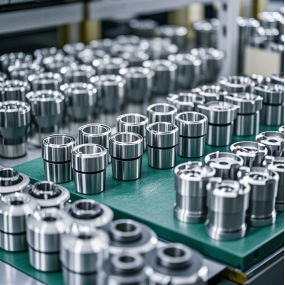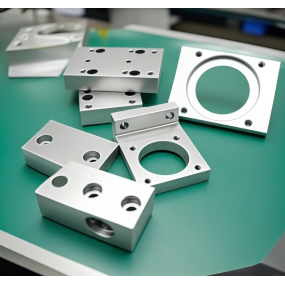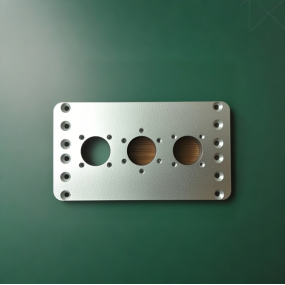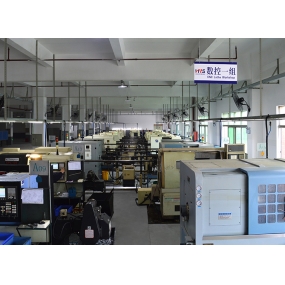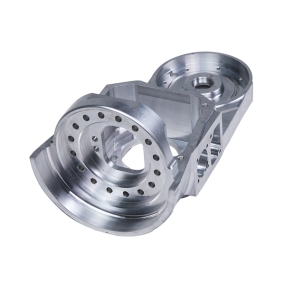1. Shearing material: refers to the process of material passing through a shearing machine to obtain a rectangular workpiece.
2, cutting: refers to the workpiece through LASER cutting or numerical control punch punching process.
3. Blanking: refers to the process of processing a product shape using a die on an ordinary punch or other equipment.
4. Punching: refers to the process of machining holes for workpieces by ordinary punching machines and molds.
5. Bending: refers to the process of forming a workpiece by a bending machine.
6. Forming: refers to the process of using molds on ordinary punches or other equipment to deform workpieces.
7. Hole extraction: also known as "flanging", refers to the process of using a mold on an ordinary punch or other equipment to form a round hole on the workpiece and turn it up.
8. Tapping: refers to the process of machining internal threads on a workpiece.
9. Reaming: refers to the process of machining small holes in a workpiece into large holes with a drill or milling cutter.
10. Countersunk hole: refers to the process of machining a taper hole on the workpiece in order to fit a connector similar to a countersunk screw.
11. Riveting: refers to the process of firmly pressing fasteners such as riveting nuts, riveting screws or riveting nut columns onto the workpiece by using a punch or hydraulic press
12. Rising rivet: refers to the process of first sinking the workpiece, and then using a punch or hydraulic press to firmly press the rising rivet nut on the workpiece.
13. Pull mother: refers to the process of using a riveting-like process. The process of firmly connecting the connecting parts such as the pull rivet nut (POP) to the workpiece with a pull mother gun.
14. Riveting: refers to the process of using a riveting gun as a tool to connect two or more workpieces closely together with pull nails.
15. Riveting: The process of connecting two or more workpieces face-to-face with rivets. If countersunk head riveting is required, the workpiece needs to be countersunk first.
16. Punching convex hull: refers to the process of forming a convex shape of a workpiece with a die in a punch or hydraulic press.
17. Punching and tearing: Also called "punching bridge", it refers to the process of forming a workpiece into a bridge-like shape with a die on a punch or hydraulic press.
18. Printing: refers to the process of using a mold to print text, symbols, or other imprints on a workpiece.
19. Corner cutting: refers to the process of cutting off the corners of the workpiece using a die on a punch or hydraulic press.
20, punching holes: refers to the ordinary punch or numerical control punch with a die on the workpiece punching holes.
21. Flattening: refers to the process of transitioning a workpiece with a certain shape to a flat one.
22. Drilling: refers to the process of drilling a workpiece with a drill bit on a drilling or milling machine.
23. Chamfering: refers to the process of machining the sharp corners of a workpiece using molds, files, grinders, etc.
24. Leveling: refers to the process of leveling the workpiece before and after processing, and using other equipment to level the workpiece.
25. Tooth return: refers to the process of repairing the second screw tooth on the pre-tapped workpiece.
26. Protective film: refers to the process of using a film that can protect the surface of the workpiece to protect the surface of the workpiece.
27. Tear off protective film: refers to the process of cleaning the surface protective film of the workpiece.
28. Shape correction: refers to the process of adjusting the workpiece that has been processed and formed.
29. Heat shrinkage: refers to the process of using heating equipment (heat gun, oven) to tighten the plastic that covers the workpiece.
30. Labeling: refers to the process of attaching the label to the designated location of the workpiece.
31. Wire drawing: refers to the process of using a wire drawing machine and abrasive belt to treat the surface of the workpiece.
32. Polishing: refers to the process of using polishing equipment to brighten the surface of a workpiece.
33. Heat treatment: refers to the process of performing special treatment to increase the hardness of the workpiece.
34. Deburring: refers to the process of removing the burr edge of the workpiece with tools such as grinders and files during Sheet Metal Processing to make the workpiece machining smooth and flat.
35. Argon arc welding: refers to the process of welding the workpiece and the workpiece by an argon arc welding machine at the edge or seam of the workpiece. It is divided into intermittent welding, full welding, etc., which should be clearly marked on the drawings.
36. Touch welding: also known as: "spot welding", refers to the process of welding the workpiece face-to-face by a touch welding machine.
37. Plant welding: refers to the process of firmly welding the plant welding screws to the workpiece with a plant welding torch.
38. Welding and grinding: mainly refers to the process of using tools such as grinders and files to make the welding scar of the workpiece smooth and flat.
39. Pretreatment: refers to the process of degreasing, rust removal, surface coating (such as phosphating film) and cleaning the workpiece with electrolytic solution before painting or powder spraying after the workpiece sheet metal processing is completed.
40. Scraping: refers to the process of using atomic ash to make up for defects on the surface of the workpiece, such as welding gaps or pits.
41. Scrape and polish: mainly refers to the process of surface polishing of the workpiece after scraping with a flat grinder or emery cloth. 42. Oil injection: refers to the process of using a special spray gun to evenly spray paint on the surface of the workpiece.
43. Powder spraying: refers to the process of using a spray gun to evenly spray powder on the surface of the workpiece.
44. Screen printing: refers to the process of using a special ink to penetrate a special grid to form text or patterns on the surface of the workpiece.
45. Electroplating: refers to the process of plating a layer of metal on the surface of a workpiece to protect or enhance its appearance.
46. Oxidation: refers to the process of forming an oxide film on the surface of a workpiece to protect or enhance its appearance.
47. Sandblasting: refers to the process of treating the surface of the workpiece by sandblasting
47. Assembly: refers to the process of assembling more than two workpieces together.
48. Packaging: refers to the process of protecting the workpiece for easy transportation.
49. Others: breaking, drawing (die), back pressure, tooth extraction (tapping after hole extraction), salad (counterweight) through hole



 Spanish
Spanish Arabic
Arabic French
French Portuguese
Portuguese Belarusian
Belarusian Japanese
Japanese Russian
Russian Malay
Malay Icelandic
Icelandic Bulgarian
Bulgarian Azerbaijani
Azerbaijani Estonian
Estonian Irish
Irish Polish
Polish Persian
Persian Boolean
Boolean Danish
Danish German
German Filipino
Filipino Finnish
Finnish Korean
Korean Dutch
Dutch Galician
Galician Catalan
Catalan Czech
Czech Croatian
Croatian Latin
Latin Latvian
Latvian Romanian
Romanian Maltese
Maltese Macedonian
Macedonian Norwegian
Norwegian Swedish
Swedish Serbian
Serbian Slovak
Slovak Slovenian
Slovenian Swahili
Swahili Thai
Thai Turkish
Turkish Welsh
Welsh Urdu
Urdu Ukrainian
Ukrainian Greek
Greek Hungarian
Hungarian Italian
Italian Yiddish
Yiddish Indonesian
Indonesian Vietnamese
Vietnamese Haitian Creole
Haitian Creole Spanish Basque
Spanish Basque

